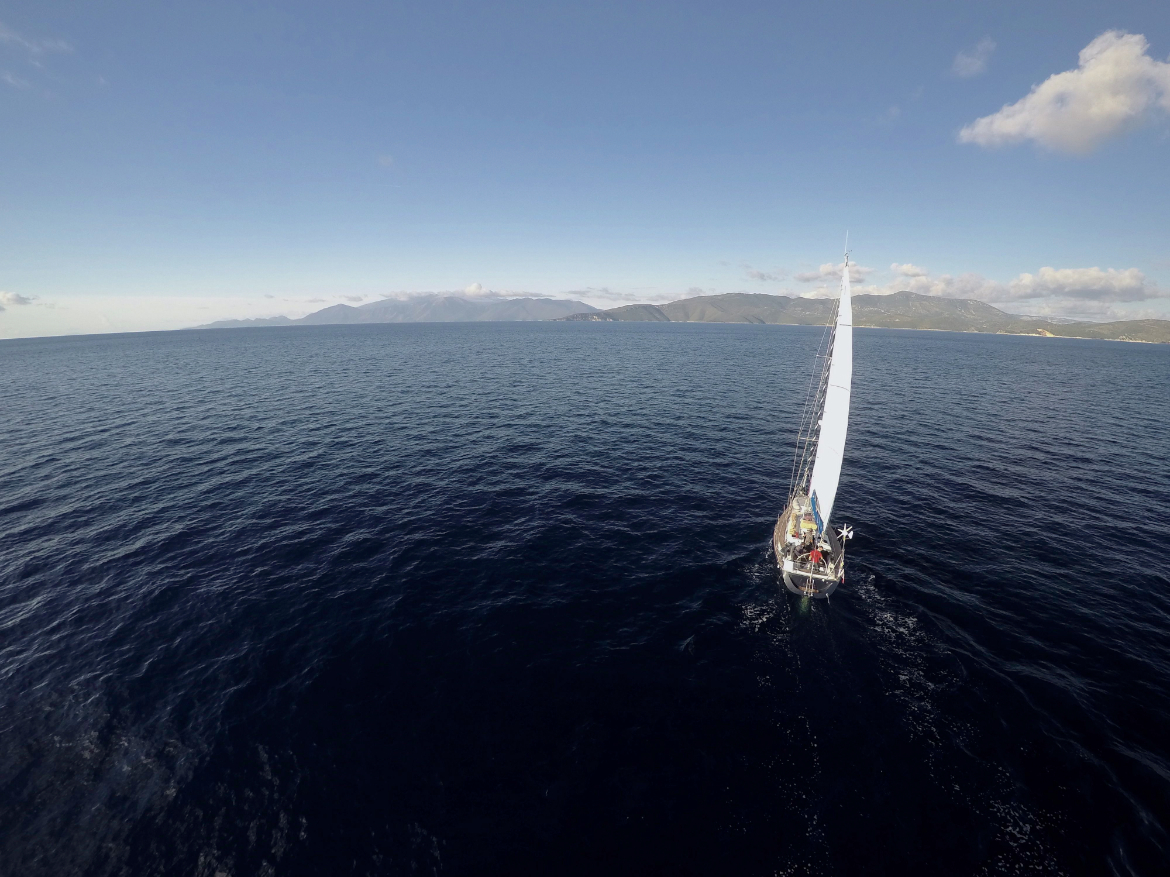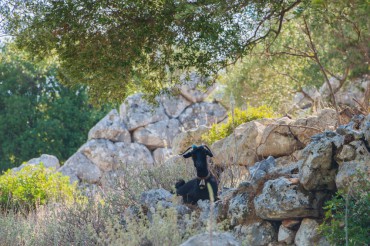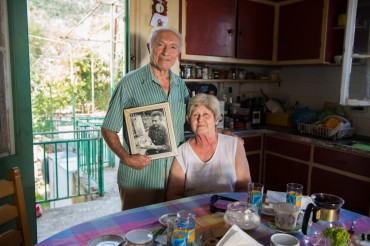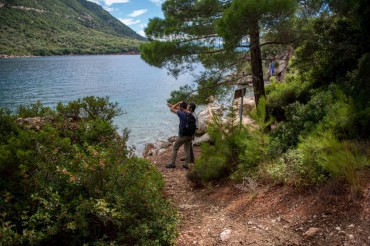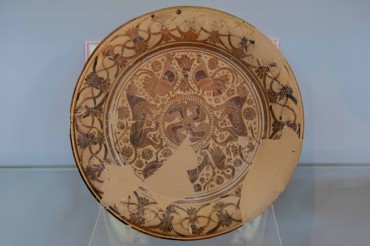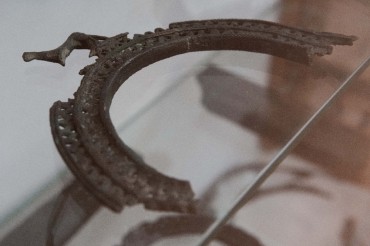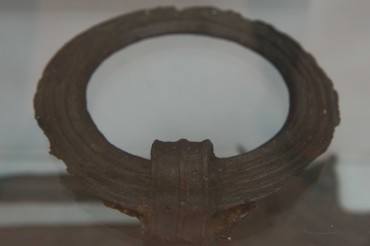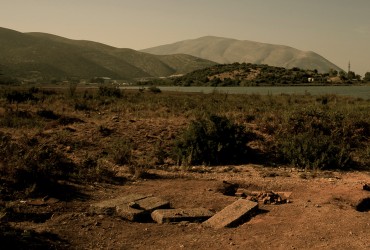On Ithaca, following Odysseus’ trail
On the narrow isthmus that connects Ithaca’s two parts, Mount Aetos stands tall. Forgetting the stifling heat, we decided to attempt the ascent after reading on a 19th century map that a promising place called «Odysseus’ palace» was in the area.
At the base of the hill, we found ourselves surrounded by ruins that could very well be Mycenaean. But our attention quickly turned to a cyclopean wall stretching all the way up to Aetos’ summit. There were no distinct paths to follow, so we used the trail carved by local goats who watched the sweating visitors with mild curiosity.
Our efforts soon paid off, as we took in the beautiful view from the summit’s lookout. Towards the West, the imposing island of Cephalonia stretches on the other side of the canal. Towards the East, Aetos offers a vantage point on the Greek coast. A settlement here would be very strategic.
Unfortunately, we were quickly brought back to reality when talking to Spiros Arsenis, former mayor of the town of Vathy and local scholar: «Many tourists come to Mount Aetos looking for the historical thrill. But if Odysseus truly lived on Ithaca, it was certainly not in this area. »
The ruins we saw had nothing to do with the Odyssey, and we were fooled by the magic of the spot. The archaeological site on Mount Aetos has been linked to the ancient city of Alalcomenia, dated two centuries after the events in Homer’s poems.
Knowing that the best archaeologists fell in the same trap brings little comfort. For example, the father of Greek archaeology, Heinrich Schliemann, conducted two series of excavations in 1868 and 1878, mainly around Alalcomenia.
Although great hopes were put in the project, the results were disappointing. Schliemann ended up packing his bags and shovels and leaving, to dig around Mycenae and Troy. Before him, others came to excavate Ithaca’s ground, in search of clues. In 1806, William Gell was one of the first to have an interest in the island’s potential.
In his footsteps, many gold-diggers – a suitable name for the pioneers of what would later become archaeology – roamed the island in search of Mycenaean ruins and Odysseus’ legendary palace.
In 1905, the German archaeologist Wilhelm Vollgraff published an article on his recent excavations on Ithaca. His disappointment is hardly concealed, as his report concludes that «if the findings weren’t conclusive enough, it is not, I believe, a coincidence, considering the nature of the soil on the island. This ground, many times built into terraces to grow vines and olive trees, could not have kept the precious deposits it may have received.»
Vollgraff reported that objects belonging to various ages were found in the same layer of soil, a solid proof that the ground had been turned time and again. Indeed, between 1811 and 1814, Ithaca was controlled by the French. During that time, the governor from Corsica allowed the looting of 200 tombs on the Alalcomenia site. The findings were sold on the antiquity markets in Europe.
It is not before the 1930s that interesting findings finally began to reward the investigators. In the North of Ithaca, around Mount Pilikata, the English archaeologist W.A. Heurtley began excavating two promising sites, the «School of Homer» and the bay of Ormos Polis.
Heurtley and his crew revealed ruins that date back to the Neolithic, along with traces of settlements from the Mycenaean period. Even if they brought hope because of the matching period with King Odysseus, no remains of a legendary palace were ever found. Heurtley’s assistant, Sylvia Benton, later exposed the most interesting discoveries on Ithaca, by digging the Loizos cave in the Bay of Ormos Polis.
To find out more about these objects, we headed to the village of Stavros, in the North of the Island, where most of them are now displayed in a small museum. A meeting was arranged with the museum’s former curator, Fotimi Couvaras, now retired. We were welcomed in her home as if lifelong family friends. Her kitchen table was always overflowing with tasty lokum, delicious snacks and juicy olives from the garden. The food was invariably accompanied by glasses of robust and woody local wine, «made from the vines that have been in the family for many generations,» proudly adds Sotiris Couvaras, Fotimi’s husband.
On the walls of the Couvaras house, there were no framed diplomas in archaeology, museology or even history. Nevertheless, Fotimi, Sotiris and their son Spiros are true scholars. During our Ithaca expedition, we spent countless hours around their kitchen table, debating the various places of the island that are mentioned in the Odyssey and talking about the text’s influence on the local inhabitants.
During one of our conversations, Fotimi recalled her very first memory of the Odyssey: «I was living in South Africa where many family members had emigrated. While our parents were off to work, our grandmother used to take care of us, and we loved listening to her telling the stories of the Odyssey. She always started a tale in the same way: On our island, a palace could be found at the top of Mount Pilikata, it belonged to Odysseus, a king who fought in the Trojan War… As you can see, we didn’t wait for the archaeologists to learn where the legendary palace was.»
Fotimi Couvaras also told us how she became the curator of the small Stavros museum: «In Greece, as soon as you dig up a little earth, you find something significant. The authorities can’t always send an official rapidly enough to document the discoveries. The findings are often entrusted to the village’s teacher, who protects them and makes them available. In Stavros, my Sotiris was the schoolteacher. At first, I gave him a little help, but over the years it became my job. The fact that I speak good English certainly helped with the scientists and the tourists.»
Slowly, the objects were arranged into a small museum. Fotimi Couvaras saw her fair share of archaeologists and historians, on their mission to reveal the mysteries of the island. In her mind, there can be no doubt: it’s near Stavros that the digging will reveal Odysseus’ tracks. «The archaeologists from England were convinced that the palace would be found on Mount Pilikata. It’s true that the spot seems strategic enough, considering the information we have from Homer’s poems. In the texts, three natural ports should be visible from Odysseus’ home. Afkhales, Frikes and Ormos Polis are three bays that coincide rather well with what’s written in the Odyssey,» adds the former museum’s curator.
One of the best things while talking with Fotimi Couvaras, is the amount of juicy anecdotes she is able to link to our case. For example, when Sylvia Benton first arrived on the island, she started questioning the locals to look for clues. Fotimi continues: «Some say that the British woman went to the first house in the village of Stavros, to meet the inhabitants. On the front porch was on old lady, and Sylvia Benton used her basic Greek to ask about Odysseus and Penelope. Upon hearing the two names, the old lady turned around and shouted: Penelope! Go get your brother Odysseus! There is a woman here who wishes to speak with you two! After this, Sylvia Benton said that there was no need to excavate, they had surely found the correct island.»
Still, doubts remain today, despite all the interesting archaeological findings. In the famous Loizos cave for example, metallic three-legged vases were found. These tripods are mentioned in the Odyssey, as a gift from king Alkinoos. Unfortunately, the cave collapsed in 1953 after the Ionian Sea was badly shaken by a powerful earthquake.
In the surroundings of Mount Pilikata, a fragment was found roughly depicting a man attached to the mast of his ship, with birds flying above his head. Furthermore, a ceramic piece was found with the inscription «Effkhrin Odysseus», a dedication to the legendary king. However, most of these archaeological artefacts are dated after the Mycenaean period that may have seen Odysseus’ reign.
The last excavations took place at the «School of Homer», in the North of Ithaca. A few archaeologists think that the remains could very well be the structure of a palace. Unfortunately, the recent economic crises put an end to the project. No papers were ever published following these latest explorations, and the few experts we later met in Athens were either very careful or even skeptical, much like Clio, our guide in the large Archaeological Museum of Athens.
But the people from Ithaca have strong faith, and some of them have founded the «Friends of Homer» association, fighting for a better acknowledgment of their archaeological, cultural and historical heritage. Thanks to their work, new excavations at the «School of Homer» are considered and could start soon.
«Time and funding should especially be assigned to document all the discoveries that are collecting dust in the Vathy’s museum’s warehouse» says Spiros Couvaras as he joins the discussion in his parent’s kitchen, in Stavros. According to Spiros, the fact that nobody could find important traces of the Mycenaean civilization on Ithaca isn’t alarming: «Although we know that our island has been inhabited since the Neolithic, it’s true that we can’t verify the theories of a Mycenaean King on Ithaca with actual archaeological proofs. Still, a few centuries after that period, the local people were persuaded that our island was indeed where Odysseus had his palace. Excavation sites such as the one in the Loizos cave are at the base of this hypothesis.»
«Many treasures are still to be found in Ithaca’s ground», can be read on the last page of a touristic brochure presenting the island to visitors. The promise is alluring, but the truth is that many archaeologists and enthusiast have been discouraged. Frustrated by the lack of groundbreaking findings, many have turned their back on the island and developed different theories on Odysseus’ kingdom. What if we should be looking elsewhere? What about the neighboring island of Cephalonia?
